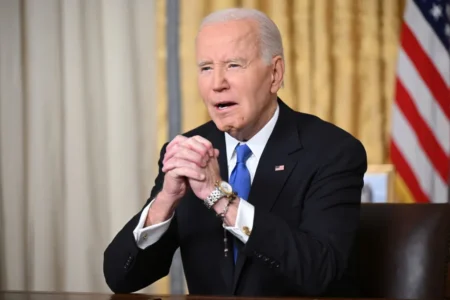In the world of politics, bold moves often lead to intense scrutiny and speculation. Recently, a fascinating theory has emerged, suggesting that President Donald Trump‘s new sweeping tariffs – which impose a minimum 10% tariff on nearly 100 countries – may have been formulated with the help of artificial intelligence. This theory has been circulating on social media, sparking heated debates about the role of AI in shaping U.S. trade policies.
The theory gained traction after several users on the platform X (formerly Twitter) claimed that they were able to replicate the same tariff plan using AI tools like OpenAI’s ChatGPT and other similar programs. This revelation has caused many to question whether the White House itself turned to AI to help craft its new economic strategy or if it’s merely an interesting coincidence.
The AI Connection: How the Theory Began
The controversy began when crypto trader Jordan “Cobie” Fish shared a screenshot of his interaction with ChatGPT. He prompted the AI to “calculate the tariffs that should be imposed on other countries so that the US is on an even playing field when it comes to the trade deficit,” setting a baseline of 10%. To his surprise, the result provided by the AI closely mirrored the tariff plan announced by the White House shortly afterward.
In the formula provided by the White House, officials explained how they calculated the tariffs: they began by determining the size of the trade deficit between the U.S. and a specific country. This number was then divided by the amount the U.S. imports from that country, and the result was halved to reach the new tariff rate. The simplicity of this approach raised eyebrows, leading some to speculate that the formula was too basic to be the work of seasoned economists.
ChatGPT, however, wasn’t entirely complimentary of the plan. It warned Fish that such a formula fails to account for “the intricate dynamics of international trade,” including “elasticities, retaliatory measures, and supply chain nuances.” Despite this caution, the striking resemblance between the AI-generated tariff plan and the one announced by the White House caught the attention of many.
Elon Musk’s AI Chatbot Grok Gets Involved
Adding fuel to the fire, Elon Musk’s AI chatbot, Grok, also created a tariff plan similar to ChatGPT’s when prompted with the same instructions. The AI warned Musk’s chatbot users that the formula should consider “production costs, subsidies, and labor standards abroad” if the goal is to create an “even playing field.” Grok, like ChatGPT, also cautioned that such a simple approach could lead to “retaliation or higher costs for US consumers.”
But it wasn’t just ChatGPT and Grok that generated similar tariff plans. Other AI programs, such as 4o, o3 high, Gemini 2.5 pro, and Claude 3.7, also produced remarkably similar formulas. This widespread pattern has only fueled suspicions that AI may have played a role in crafting the new tariffs.
The Experts Weigh In: Is AI Behind This?
While the theory remains speculative, several experts have chimed in with their opinions. Economist James Surowiecki, known for his clear and concise analyses of economic matters, expressed skepticism about the simplicity of the formula. Surowiecki reverse-engineered the “fake tariff rates” and referred to the resulting calculations as “extraordinary nonsense.” He raised concerns about the over-simplification of such a complex issue, pointing out that the formula disregards the broader implications of international trade, including political dynamics and long-term economic impacts.
Surowiecki’s dismissal of the formula as overly simplistic mirrors many critics’ concerns about the effectiveness of the tariff plan. A complex issue like global trade cannot be solved with a straightforward formula, no matter how efficient it might seem on paper. And while AI tools like ChatGPT can provide quick answers, they might lack the nuanced understanding that experienced economists and trade experts bring to the table.
Trump’s Tariffs: A Move to Boost Domestic Manufacturing?
When President Trump announced the new tariffs, he positioned them as a necessary step to boost domestic manufacturing, generate revenue for the U.S., and restore fairness to global trade. “We need to level the playing field,” Trump declared, arguing that the tariffs would help American workers and industries by reducing the trade deficit with foreign nations. His rhetoric suggested that the tariffs were designed to be a cornerstone of his economic policies, aimed at making the U.S. more competitive on the global stage.
But the simplicity of the tariff formula has left many questioning whether such a complex issue can truly be boiled down to a simple mathematical equation. While the theory that AI may have played a role in shaping the tariffs is intriguing, there is no definitive proof to suggest that the White House relied on artificial intelligence to formulate the new trade policies.
The Bigger Picture: A Provocative Theory with No Clear Answers
The idea that AI helped shape Trump’s new tariffs is a provocative one, and it’s clear that the theory has sparked widespread curiosity and debate. Whether or not the White House used AI to “do its homework” is still up in the air. However, the resemblance between the AI-generated tariff plans and the official policy has prompted many to question the role of technology in modern governance.
It’s important to recognize that while AI tools like ChatGPT and Grok are powerful, they are not infallible. They can provide quick calculations and insights, but they may lack the depth of understanding needed to navigate the complexities of global trade. The tariff formulas generated by these AI systems may seem simple, but as experts have pointed out, trade policies are far more intricate and require a more nuanced approach.
At the end of the day, the theory that AI helped craft Trump’s new tariffs may just be an interesting coincidence, or it could signal a larger shift in how governments and leaders approach policymaking in the digital age. Only time will tell whether artificial intelligence plays a greater role in shaping the future of global trade.
As the controversy continues to unfold, one thing is clear: the intersection of technology, politics, and economics is an area of growing interest and scrutiny. Whether or not AI is behind Trump’s tariffs, the conversation about its role in modern policymaking is far from over.







